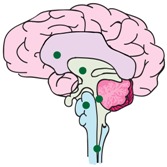Table 1.
Subtypes of pediatric high-grade gliomas, relevant mutations and features, and pediatric clinical trials designed to target these mutations. Diffuse intrinsic pontine glioma (DIPG), histone H3 K27M variant (H3-K27M), TP53, ACVR1, activin receptor-like kinase-2 (ALK2), ATRX-DAXX, platelet-derived growth factor receptor A (PDGFRA), pan-histone deacetylase (HDAC), FGFR1, MAPK, BRAF, MEK, NTRK, TRK, mTOR, IDH1, MYCN, TERT, SETD2, WEE1, NCT.
| Pediatric High-Grade Gliomas: Mutations, Features, and Novel Clinical Therapies | ||||
|---|---|---|---|---|
| Anatomical Classification | Defining Mutations | Features | Other Mutations | Targeted Therapies and Pediatric Clinical Trials |
Midline location
|
|
|
|
|
|
|
|
||
|
|
|
||
Hemispheric location
|
|
|
|
|
|
|
|
||
|
|
|||
|
|
|
||
* All NCT entries indicate trial number listed in clinicaltrials.gov.
